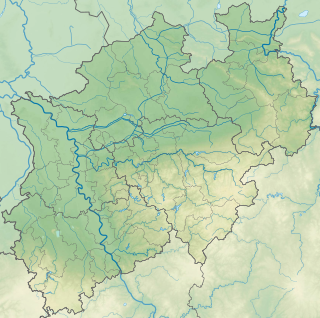Hasslinghauser back
| Hasslinghauser back | |||
|---|---|---|---|
| Panorama of Gevelsberg, behind the Haßlinghauser ridge | |||
| Systematics according to | Handbook of the natural spatial structure of Germany | ||
| Greater region 1st order | Low mountain range threshold | ||
| Greater region 2nd order | Rhenish Slate Mountains | ||
| Main unit group | 33 → Süderbergland |
||
| About main unit | 337 → Bergisch-Sauerland lowlands |
||
| 4th order region (main unit) |
337 1 → Niederbergisch-Märkisches hill country |
||
| 5th order region | 337 1 .1 → Bergisch-Märkisches hill country |
||
| Natural space |
337 1 .15 → Haßlinghauser Ridge |
||
| Geographical location | |||
| Coordinates | 51 ° 19 '56.7 " N , 7 ° 16' 50.4" E | ||
|
|||
| local community | Hagen , Wetter (Ruhr) , Gevelsberg , Sprockhövel , Wuppertal | ||
| state | North Rhine-Westphalia | ||
| Country | Germany | ||
The Haßlinghauser Ridge is a natural spatial unit with the order number 337 1 .15. In Wuppertal , the local population, official bodies of the city of Wuppertal and the local press refer to the elevations north of the Wupper as belonging to the ridge as Wuppertaler Nordhöhen .
The elongated ridge extends as a sequence of flat, slightly undulating mountain ranges in the form of a narrow strip in an east-west direction north of the Wupper - Ennepe valley furrow. It begins at the edge of the Hagener Kessel in the hall in the Volmetal between Hagen and Vorhalle and runs through Hagen- Geweke , Hagen- Spielbrink , Wetter (Ruhr) - Schmandbruch , Gevelsberg - Berge , Gevelsberg- Asbeck , Sprockhövel - Haßlinghausen , Wuppertal - Nachbarebreck , Wuppertal- Hatzfeld , Wuppertal- Uellendahl , Wuppertal- Katernberg to the north of Wuppertal- Vohwinkel with the forest area Osterholz on the border with Haan - Gruiten .
In the west in Osterholz the height is approx. 200 m, rises to 300 m at Einern and Schmiedestrasse and drops to 250 m at Haßlinghausen. Geologically, the ridge consists of empty Upper Carboniferous or Upper Devonian Grauwacken , slates , sandstones or quartzites . The ridge, which is structured from the rounded hardness ridge and intervening hollows , drops 120 m deep in the northeast to the Ardeypforte (natural space unit 337 1 .4) near Wetter- Volmarstein . At an angle of 30 °, the drop to the lower Volme is steep, whereas the drop to the south to the lower Ennepe is gentle and to the central Wupper it is clearly terraced. In the north-west, the Haßlinghauser Ridge merges into the Märkische stratified rib land (natural spatial unit 337 1 .13) over small peaks. In the west, the ridge forms the watershed between the river systems of the Wupper and the Ruhr . The soils are mostly of medium depth, sandy-loamy to stony with moderately developed brown earth horizons .
The name and natural counterpart to the north heights are the south heights south of the Wupper.
Individual evidence
- ↑ Handbook of the natural spatial structure of Germany: Sheet 108/109: Düsseldorf / Erkelenz (Karlheinz Paffen, Adolf Schüttler, Heinrich Müller-Miny) 1963; 55 p. And digital version of the corresponding map (PDF; 7.4 MB)
- ↑ a b Handbook of the natural spatial structure of Germany: sheet 110: Arnsberg (Martin Bürgener) 1969; 80 p. And digital version of the associated map (PDF; 5.9 MB)

